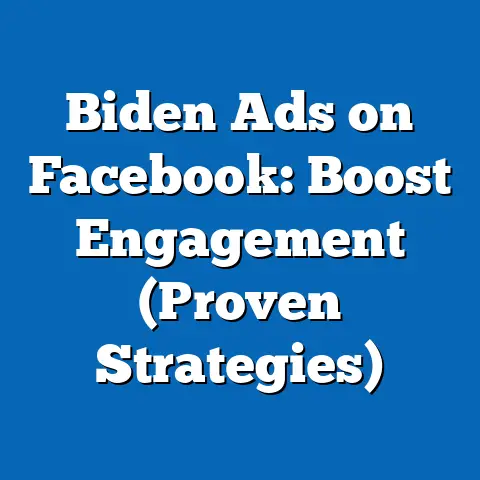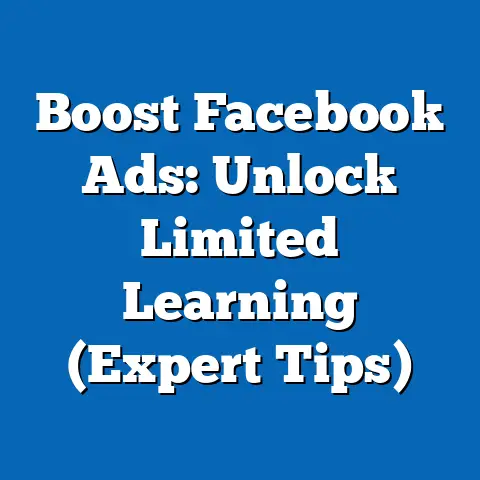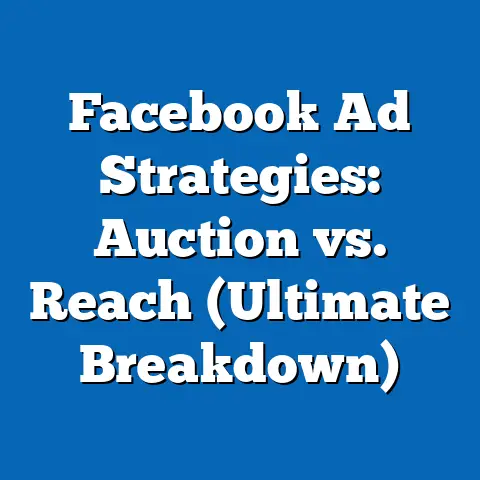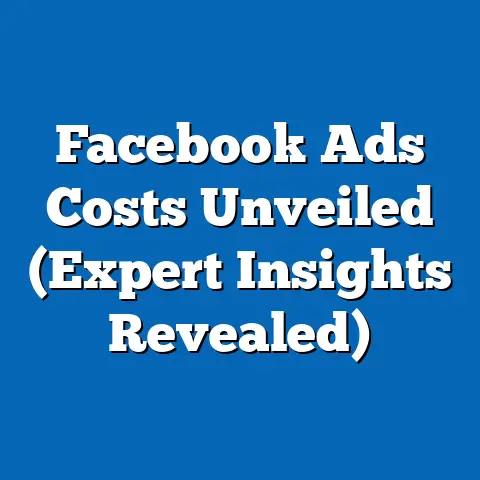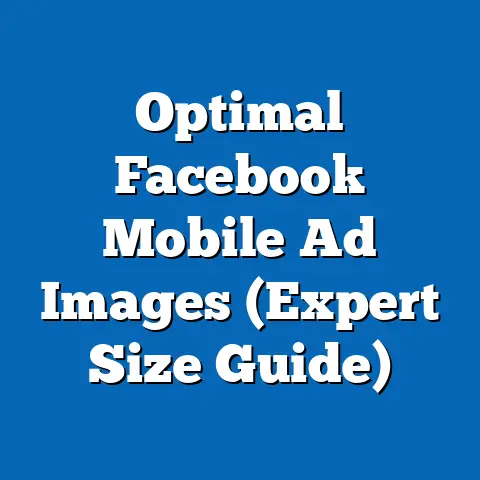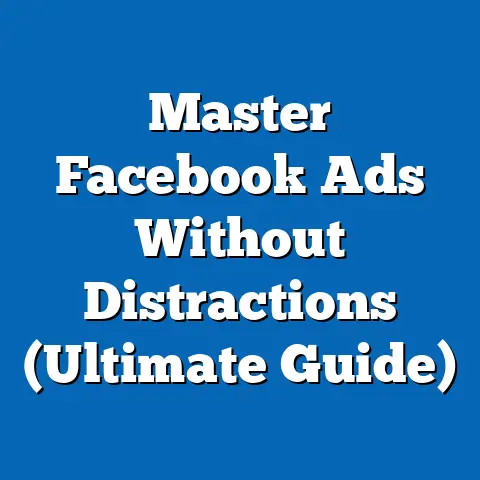Unlocking Facebook Lead Ads: A Visual Guide (Ad Mastery)
I’ve seen countless businesses stumble with Facebook Lead Ads, often making the same critical error: launching campaigns without a clear understanding of their target audience or failing to create visually engaging ads. It’s like fishing in the ocean without knowing what kind of fish you’re trying to catch or what bait to use! The results? Wasted ad spend and a trickle of low-quality leads.
I’ve personally witnessed campaigns where companies spent thousands of dollars only to generate leads that were completely irrelevant to their business. They hadn’t taken the time to define their ideal customer or craft compelling ad creatives. According to recent statistics, poorly targeted ads can decrease conversion rates by as much as 50%, turning potential customers away before they even have a chance to learn about your product or service.
That’s why I’m writing this comprehensive, visual guide. My goal is to equip you with the knowledge and tools you need to unlock the full potential of Facebook Lead Ads, avoid those common pitfalls, and start generating high-quality leads that drive real business results. This isn’t just about creating ads; it’s about mastering the art of lead generation on Facebook.
Section 1: Understanding Facebook Lead Ads
What are Facebook Lead Ads?
Facebook Lead Ads are a specific type of ad format designed to collect contact information from potential customers directly within the Facebook platform. Unlike traditional ads that drive traffic to your website or landing page, Lead Ads allow users to submit their information without ever leaving Facebook. This streamlined process significantly reduces friction and often leads to higher conversion rates.
Think of it as a digital business card exchange, but instead of handing out a physical card, you’re presenting a pre-populated form that users can submit with just a few taps.
Here’s how they work:
- User sees your ad: Your target audience sees your eye-catching Lead Ad in their Facebook or Instagram feed.
- User clicks the call-to-action: The ad features a compelling call-to-action button (e.g., “Sign Up,” “Get a Quote,” “Download Now”).
- Lead form appears: Upon clicking, a pre-filled form pops up directly within the Facebook app. This form is populated with information the user has already shared with Facebook (e.g., name, email, phone number).
- User submits the form: The user reviews the information, makes any necessary adjustments, and submits the form.
- You receive the lead information: The lead’s information is then sent directly to your CRM or marketing automation system.
Visual: An infographic illustrating the user flow of a Facebook Lead Ad, from seeing the ad to submitting the form.
Why are Lead Ads Important for Lead Generation?
Lead generation is the lifeblood of any successful business. It’s the process of attracting and capturing the interest of potential customers, ultimately converting them into paying clients. In today’s digital landscape, effective lead generation is more crucial than ever.
Facebook Lead Ads play a vital role in this process because they offer several key advantages:
- Reduced Friction: By eliminating the need to navigate to an external website, Lead Ads significantly reduce the friction involved in the lead capture process. This leads to higher conversion rates and more leads at a lower cost.
- Mobile Optimization: Lead Ads are designed to be mobile-friendly, providing a seamless experience for users on smartphones and tablets. Given that the majority of Facebook users access the platform on mobile devices, this is a significant advantage.
- Pre-populated Forms: The pre-populated forms make it incredibly easy for users to submit their information with minimal effort. This increases the likelihood of conversion, especially among mobile users who may be hesitant to type out lengthy forms on their small screens.
- Advanced Targeting: Facebook’s powerful audience targeting capabilities allow you to reach highly specific demographics, interests, and behaviors. This ensures that your ads are seen by the most relevant potential customers.
- Integration with CRM Systems: Lead Ads can be seamlessly integrated with your CRM or marketing automation system, allowing you to automatically capture and nurture leads.
Visual: A bar chart comparing the conversion rates of Lead Ads versus traditional landing pages.
Leveraging Facebook’s Audience Targeting
Facebook’s unparalleled audience targeting capabilities are what truly make Lead Ads a powerful tool for lead generation. You can target your ads based on a wide range of factors, including:
- Demographics: Age, gender, location, education, job title, etc.
- Interests: Hobbies, passions, brands they follow, pages they like, etc.
- Behaviors: Purchase history, website activity, mobile device usage, etc.
- Custom Audiences: Upload your existing customer lists to create targeted audiences based on your current customer base.
- Lookalike Audiences: Create new audiences that resemble your best customers based on their shared characteristics and behaviors.
Example:
Let’s say you’re a real estate agent looking to generate leads for new home buyers in a specific city. You could target your Lead Ads to users who:
- Are between the ages of 25 and 45 (a common age range for first-time homebuyers).
- Live in or near the target city.
- Have shown interest in real estate websites, home improvement pages, or mortgage calculators.
- Have a “High” or “Very High” likelihood of moving within the next 6-12 months (based on Facebook’s predictive analytics).
By combining these targeting options, you can ensure that your ads are seen by the most qualified potential customers, increasing your chances of generating high-quality leads.
Visual: A graphic illustrating the different targeting options available in Facebook Ads Manager.
Key Takeaway: Facebook Lead Ads are a powerful tool for generating high-quality leads by reducing friction, leveraging mobile optimization, and utilizing Facebook’s advanced targeting capabilities.
Next Steps: Consider your target audience and how you can leverage Facebook’s targeting options to reach them effectively.
Section 2: Setting Up Your Facebook Lead Ads
Now, let’s dive into the step-by-step process of creating a Facebook Lead Ad. I’ll guide you through each stage, providing visual aids and highlighting best practices along the way.
Step 1: Accessing Ads Manager
The first step is to access Facebook Ads Manager. You can do this by:
- Logging into your Facebook account.
- Clicking the “Menu” icon (usually represented by three horizontal lines) in the top right corner of the screen.
- Selecting “Ads Manager” from the dropdown menu.
If you don’t see “Ads Manager” in the dropdown, you may need to click “See More” to expand the list.
Visual: Screenshot of the Facebook dropdown menu with “Ads Manager” highlighted.
Step 2: Choosing the Right Campaign Objective
Once you’re in Ads Manager, click the “+ Create” button to start a new campaign. You’ll be presented with a list of campaign objectives. For Lead Ads, you’ll want to choose either “Lead Generation” or “Conversions”.
- Lead Generation: This objective is specifically designed to collect leads directly within Facebook. It optimizes your ads for lead form submissions.
- Conversions: This objective focuses on driving conversions on your website or app, but you can also use it to track lead form submissions as conversions.
For simplicity, I recommend choosing the “Lead Generation” objective.
Visual: Screenshot of the Facebook Ads Manager campaign objective selection screen, with “Lead Generation” highlighted.
Step 3: Setting Up Audience Targeting
This is where you define who you want to see your ads. As I mentioned earlier, Facebook offers a wide range of targeting options.
- Define your core audience: This includes demographics (age, gender, location), interests, and behaviors.
- Create custom audiences: Upload your existing customer lists or website visitor data to create targeted audiences.
- Build lookalike audiences: Expand your reach by targeting users who resemble your best customers.
Pro Tip: Start with a broad audience and gradually narrow it down based on performance data. This will help you identify the most effective targeting options for your campaign.
Visual: Screenshot of the Facebook Ads Manager audience targeting section, showing options for demographics, interests, and behaviors.
Step 4: Designing the Ad Creative
Your ad creative is what will grab the attention of your target audience and entice them to submit their information. It consists of several key elements:
- Visual (Image or Video): This is the first thing people will see, so it needs to be eye-catching and relevant to your offer.
- Headline: This is the main text that appears above or below your visual. It should be concise, compelling, and clearly communicate the value proposition of your offer.
- Description: This is the longer text that provides more details about your offer. It should highlight the benefits of submitting the lead form and address any potential concerns.
- Call-to-Action Button: This is the button that encourages users to submit the lead form. Choose a call-to-action that is relevant to your offer (e.g., “Sign Up,” “Get a Quote,” “Download Now”).
Visual: Examples of high-performing Facebook Lead Ads in various industries, highlighting the key elements of the ad creative.
Step 5: Creating the Lead Form
The lead form is where users will submit their information. It’s crucial to design a form that is both effective and user-friendly.
-
Choose the right form type: Facebook offers two form types:
- More Volume: This form type is designed to maximize the number of leads you generate. It uses a simplified design and pre-populated fields to make it as easy as possible for users to submit their information.
- Higher Intent: This form type is designed to generate higher-quality leads. It includes a review step that allows users to confirm their information before submitting the form.
I recommend starting with the “More Volume” form type to maximize lead generation. 2. Select the information you want to collect: Choose the fields that are most relevant to your business. Common fields include name, email, phone number, and job title. 3. Add custom questions: You can add custom questions to gather more specific information about your leads. However, be careful not to ask too many questions, as this can deter users from submitting the form. 4. Write a compelling privacy policy: You’re required to include a link to your privacy policy in the lead form. Make sure your privacy policy is clear, concise, and easy to understand. 5. Add a thank you screen: After users submit the form, they’ll see a thank you screen. Use this screen to thank them for their interest and provide them with next steps (e.g., visit your website, download a resource, contact you directly).
Choose the right form type: Facebook offers two form types:
- More Volume: This form type is designed to maximize the number of leads you generate. It uses a simplified design and pre-populated fields to make it as easy as possible for users to submit their information.
- Higher Intent: This form type is designed to generate higher-quality leads. It includes a review step that allows users to confirm their information before submitting the form.
I recommend starting with the “More Volume” form type to maximize lead generation. 2. Select the information you want to collect: Choose the fields that are most relevant to your business. Common fields include name, email, phone number, and job title. 3. Add custom questions: You can add custom questions to gather more specific information about your leads. However, be careful not to ask too many questions, as this can deter users from submitting the form. 4. Write a compelling privacy policy: You’re required to include a link to your privacy policy in the lead form. Make sure your privacy policy is clear, concise, and easy to understand. 5. Add a thank you screen: After users submit the form, they’ll see a thank you screen. Use this screen to thank them for their interest and provide them with next steps (e.g., visit your website, download a resource, contact you directly).
Visual: Screenshot of the Facebook Ads Manager lead form creation screen, showing the different form types, fields, and customization options.
Common Pitfalls and How to Avoid Them:
- Poor targeting: Failing to target the right audience is a common mistake that can lead to wasted ad spend and low-quality leads.
- Solution: Take the time to define your ideal customer and leverage Facebook’s advanced targeting capabilities to reach them effectively.
- Uncompelling ad creative: If your ad creative isn’t eye-catching and relevant, people won’t be motivated to submit the lead form.
- Solution: Invest in high-quality visuals and write compelling ad copy that clearly communicates the value proposition of your offer.
- Too many form fields: Asking too many questions can deter users from submitting the form.
- Solution: Keep your lead form short and sweet. Only ask for the information that is absolutely necessary.
- Ignoring data protection regulations: Failing to comply with data protection regulations can lead to legal trouble and damage your reputation.
- Solution: Ensure that your lead form includes a clear and concise privacy policy and that you are collecting and using data in accordance with all applicable laws and regulations.
- Solution: Take the time to define your ideal customer and leverage Facebook’s advanced targeting capabilities to reach them effectively.
- Solution: Invest in high-quality visuals and write compelling ad copy that clearly communicates the value proposition of your offer.
- Solution: Keep your lead form short and sweet. Only ask for the information that is absolutely necessary.
- Solution: Ensure that your lead form includes a clear and concise privacy policy and that you are collecting and using data in accordance with all applicable laws and regulations.
Key Takeaway: Setting up Facebook Lead Ads involves a step-by-step process, from accessing Ads Manager to designing the ad creative and creating the lead form. Avoiding common pitfalls and following best practices will maximize your chances of success.
Next Steps: Start creating your own Facebook Lead Ad campaign, following the steps outlined above.
Section 3: Crafting Compelling Ad Creative
The ad creative is the face of your campaign. It’s what catches the eye, sparks interest, and ultimately drives users to submit their information. So, how do you craft compelling ad creative that converts?
Elements of Successful Ad Creative
Let’s break down the key elements:
-
Headline: This is your first impression. It needs to be short, attention-grabbing, and clearly communicate the value of your offer. Think of it as the subject line of an email – it needs to entice people to click.
- Example: “Free Guide: 5 Secrets to Doubling Your Sales Leads”
-
Visual (Image or Video): A picture is worth a thousand words, and a video even more. Choose visuals that are high-quality, relevant to your offer, and visually appealing.
-
Example: A high-resolution image of your product in action, or a short video showcasing the benefits of your service.
-
Description: This is where you provide more details about your offer and address any potential concerns. Keep it concise, highlight the benefits, and include a clear call-to-action.
-
Example: “Download our free guide today and learn the proven strategies that top sales professionals use to generate more leads and close more deals. Limited time offer!”
-
Call-to-Action Button: This is the final nudge that encourages users to submit the lead form. Choose a call-to-action that is relevant to your offer and creates a sense of urgency.
-
Examples: “Sign Up,” “Get a Quote,” “Download Now,” “Learn More”
Headline: This is your first impression. It needs to be short, attention-grabbing, and clearly communicate the value of your offer. Think of it as the subject line of an email – it needs to entice people to click.
- Example: “Free Guide: 5 Secrets to Doubling Your Sales Leads”
-
Visual (Image or Video): A picture is worth a thousand words, and a video even more. Choose visuals that are high-quality, relevant to your offer, and visually appealing.
-
Example: A high-resolution image of your product in action, or a short video showcasing the benefits of your service.
-
Description: This is where you provide more details about your offer and address any potential concerns. Keep it concise, highlight the benefits, and include a clear call-to-action.
-
Example: “Download our free guide today and learn the proven strategies that top sales professionals use to generate more leads and close more deals. Limited time offer!”
-
Call-to-Action Button: This is the final nudge that encourages users to submit the lead form. Choose a call-to-action that is relevant to your offer and creates a sense of urgency.
-
Examples: “Sign Up,” “Get a Quote,” “Download Now,” “Learn More”
Visual (Image or Video): A picture is worth a thousand words, and a video even more. Choose visuals that are high-quality, relevant to your offer, and visually appealing.
Example: A high-resolution image of your product in action, or a short video showcasing the benefits of your service.
Description: This is where you provide more details about your offer and address any potential concerns. Keep it concise, highlight the benefits, and include a clear call-to-action.
Example: “Download our free guide today and learn the proven strategies that top sales professionals use to generate more leads and close more deals. Limited time offer!”
Call-to-Action Button: This is the final nudge that encourages users to submit the lead form. Choose a call-to-action that is relevant to your offer and creates a sense of urgency.
Examples: “Sign Up,” “Get a Quote,” “Download Now,” “Learn More”
Visual: A side-by-side comparison of a poorly designed ad creative versus a well-designed ad creative, highlighting the differences in headline, visual, description, and call-to-action.
Examples of High-Performing Ads
Let’s look at some real-world examples of high-performing Facebook Lead Ads:
-
Example 1: SaaS Company Offering a Free Trial
- Headline: “Get a Free 14-Day Trial of [Software Name]”
- Visual: A short video showcasing the key features and benefits of the software.
- Description: “Experience the power of [Software Name] for yourself. Sign up for a free 14-day trial and see how it can help you boost your productivity and streamline your workflow.”
- Call-to-Action Button: “Sign Up”
Why it works: The headline is clear and concise, the video is engaging, the description highlights the benefits, and the call-to-action is relevant to the offer. * Example 2: Real Estate Agent Offering a Free Home Valuation
- Headline: “Find Out What Your Home is Worth”
- Visual: A high-quality image of a beautiful home.
- Description: “Get a free, no-obligation home valuation from a local real estate expert. Find out how much your home is worth in today’s market.”
- Call-to-Action Button: “Get a Quote”
Why it works: The headline is intriguing, the image is visually appealing, the description highlights the value proposition, and the call-to-action is clear and concise. * Example 3: E-commerce Store Offering a Discount Code
- Headline: “Get 20% Off Your First Order”
- Visual: An image collage showcasing the store’s most popular products.
- Description: “Sign up for our email list and get 20% off your first order. Discover the latest trends and exclusive deals.”
- Call-to-Action Button: “Sign Up”
Why it works: The headline offers a clear incentive, the image collage showcases the product range, the description highlights the benefits, and the call-to-action is relevant to the offer.
Example 1: SaaS Company Offering a Free Trial
- Headline: “Get a Free 14-Day Trial of [Software Name]”
- Visual: A short video showcasing the key features and benefits of the software.
- Description: “Experience the power of [Software Name] for yourself. Sign up for a free 14-day trial and see how it can help you boost your productivity and streamline your workflow.”
- Call-to-Action Button: “Sign Up”
Why it works: The headline is clear and concise, the video is engaging, the description highlights the benefits, and the call-to-action is relevant to the offer. * Example 2: Real Estate Agent Offering a Free Home Valuation
- Headline: “Find Out What Your Home is Worth”
- Visual: A high-quality image of a beautiful home.
- Description: “Get a free, no-obligation home valuation from a local real estate expert. Find out how much your home is worth in today’s market.”
- Call-to-Action Button: “Get a Quote”
Why it works: The headline is intriguing, the image is visually appealing, the description highlights the value proposition, and the call-to-action is clear and concise. * Example 3: E-commerce Store Offering a Discount Code
- Headline: “Get 20% Off Your First Order”
- Visual: An image collage showcasing the store’s most popular products.
- Description: “Sign up for our email list and get 20% off your first order. Discover the latest trends and exclusive deals.”
- Call-to-Action Button: “Sign Up”
Why it works: The headline offers a clear incentive, the image collage showcases the product range, the description highlights the benefits, and the call-to-action is relevant to the offer.
Visual: Screenshots of the examples mentioned above, showcasing the ad creative in action.
A/B Testing Your Creative
Don’t just guess what works – test it! A/B testing involves creating multiple versions of your ad creative and running them simultaneously to see which performs best.
- Test different headlines: Try different wording, length, and tone.
- Test different visuals: Experiment with different images and videos.
- Test different descriptions: Try different lengths, benefits, and calls-to-action.
- Test different call-to-action buttons: See which call-to-action generates the most clicks.
Pro Tip: Only change one element at a time when A/B testing. This will allow you to isolate the impact of each element and determine which is most effective.
Visual: A chart illustrating the results of an A/B test, showing the performance of different headlines, visuals, and descriptions.
Visual Checklist for Compelling Ad Creative
Here’s a quick visual checklist to ensure you’re on the right track:
- [] Is the headline short, attention-grabbing, and clear?
- [] Is the visual high-quality, relevant, and visually appealing?
- [] Does the description highlight the benefits and address potential concerns?
- [] Is the call-to-action button relevant to the offer and create a sense of urgency?
- [] Have you A/B tested different versions of your ad creative?
Key Takeaway: Crafting compelling ad creative involves understanding the key elements, learning from successful examples, and A/B testing different versions to optimize performance.
Next Steps: Review your existing ad creative and identify areas for improvement. Start A/B testing different headlines, visuals, and descriptions to see what resonates best with your target audience.
Section 4: Optimizing Your Lead Forms
The lead form is the final hurdle between your ad and a valuable lead. A poorly designed form can deter potential customers, while a well-optimized form can significantly increase your conversion rates.
The Significance of Lead Forms
Think of your lead form as a conversation starter. It’s your opportunity to gather valuable information about your potential customers and qualify them for your products or services.
A well-designed lead form should:
- Be concise and easy to complete.
- Ask only the most relevant questions.
- Provide a seamless and user-friendly experience.
- Comply with data protection regulations.
Visual: A comparison of a poorly designed lead form versus a well-designed lead form, highlighting the differences in length, questions, and user experience.
Examples of Well-Optimized Lead Forms
Let’s look at some examples of well-optimized lead forms:
-
Example 1: Insurance Company Offering a Free Quote
- Fields: Name, Email, Phone Number, Age, Type of Insurance (dropdown menu)
- Custom Question: “Do you currently have insurance coverage?” (Yes/No)
- Why it works: The form is short and sweet, asking only the most relevant questions. The dropdown menu makes it easy for users to select their type of insurance. The custom question helps qualify leads and determine their level of interest.
-
Example 2: Marketing Agency Offering a Free Consultation
-
Fields: Name, Email, Company Name, Website URL, Job Title
- Custom Question: “What are your biggest marketing challenges?” (Open-ended text field)
- Why it works: The form gathers valuable information about the lead’s company and marketing needs. The open-ended question allows leads to express their challenges in their own words, providing valuable insights for the agency.
-
Example 3: E-commerce Store Offering a Discount Code
-
Fields: Name, Email, Date of Birth
- Why it works: The form is incredibly simple, asking only for the bare minimum information. The date of birth field allows the store to personalize marketing messages and offer birthday discounts.
Example 1: Insurance Company Offering a Free Quote
- Fields: Name, Email, Phone Number, Age, Type of Insurance (dropdown menu)
- Custom Question: “Do you currently have insurance coverage?” (Yes/No)
- Why it works: The form is short and sweet, asking only the most relevant questions. The dropdown menu makes it easy for users to select their type of insurance. The custom question helps qualify leads and determine their level of interest.
-
Example 2: Marketing Agency Offering a Free Consultation
-
Fields: Name, Email, Company Name, Website URL, Job Title
- Custom Question: “What are your biggest marketing challenges?” (Open-ended text field)
- Why it works: The form gathers valuable information about the lead’s company and marketing needs. The open-ended question allows leads to express their challenges in their own words, providing valuable insights for the agency.
-
Example 3: E-commerce Store Offering a Discount Code
-
Fields: Name, Email, Date of Birth
- Why it works: The form is incredibly simple, asking only for the bare minimum information. The date of birth field allows the store to personalize marketing messages and offer birthday discounts.
Example 2: Marketing Agency Offering a Free Consultation
Fields: Name, Email, Company Name, Website URL, Job Title
Example 3: E-commerce Store Offering a Discount Code
Fields: Name, Email, Date of Birth
Visual: Screenshots of the examples mentioned above, showcasing the lead forms in action.
Customizing Questions and Fields
The key to optimizing your lead form is to customize it based on your target audience and campaign goals.
- Consider your target audience: What information do you need to know about them to qualify them as a lead?
- Think about your campaign goals: What are you trying to achieve with this campaign? Are you trying to generate leads for a specific product or service?
- Keep it short and sweet: Only ask for the information that is absolutely necessary.
- Use dropdown menus and multiple-choice questions: These make it easier for users to submit their information.
- Add a custom question: This can help you gather more specific information about your leads and qualify them for your products or services.
Pro Tip: Use conditional logic to show or hide questions based on the user’s previous answers. This can help you personalize the form and gather more relevant information.
Ensuring Compliance with Data Protection Regulations
Data protection regulations, such as GDPR and CCPA, are designed to protect the privacy of individuals’ personal data. It’s crucial to comply with these regulations when collecting leads through Facebook Lead Ads.
- Include a clear and concise privacy policy: Your privacy policy should explain how you collect, use, and protect personal data.
- Obtain consent from users before collecting their data: Make sure users understand how their data will be used and that they have the option to opt-out.
- Provide users with access to their data: Allow users to access, correct, or delete their personal data upon request.
- Implement security measures to protect data: Protect personal data from unauthorized access, use, or disclosure.
Key Takeaway: Optimizing your lead forms involves understanding the significance of lead forms, learning from well-optimized examples, customizing questions and fields, and ensuring compliance with data protection regulations.
Next Steps: Review your existing lead forms and identify areas for improvement. Customize your questions and fields based on your target audience and campaign goals. Ensure that your lead forms comply with all applicable data protection regulations.
Section 5: Analyzing and Measuring Success
You’ve launched your Facebook Lead Ads campaign, but the work doesn’t stop there. It’s crucial to analyze your results and measure your success to ensure that you’re getting the most out of your ad spend.
Metrics That Matter
Here are some key metrics to track when measuring the success of Facebook Lead Ads:
- Cost Per Lead (CPL): This is the average cost of generating one lead. It’s calculated by dividing your total ad spend by the number of leads generated.
- Conversion Rate: This is the percentage of users who submit the lead form after clicking on your ad.
- Lead Quality: This is a subjective metric that measures the quality of the leads you generate. Are they qualified for your products or services? Are they likely to convert into paying customers?
- Return on Ad Spend (ROAS): This is the amount of revenue you generate for every dollar you spend on advertising.
Visual: A table defining each metric, explaining how it’s calculated, and providing benchmarks for good, average, and poor performance.
Tracking and Analyzing Metrics
Facebook Ads Manager provides a wealth of data that you can use to track and analyze your campaign performance.
- Customize your columns: Choose the metrics that are most relevant to your business and add them to your Ads Manager columns.
- Segment your data: Segment your data by audience, ad creative, and lead form to identify what’s working and what’s not.
- Track your metrics over time: Monitor your metrics over time to identify trends and patterns.
Visual: A screenshot of Facebook Ads Manager, showing how to customize columns and segment data.
Interpreting the Data
Once you’ve collected the data, it’s time to interpret it and make informed decisions about your future campaigns.
- High CPL: If your CPL is high, it could indicate that your targeting is too broad, your ad creative is not compelling, or your lead form is not optimized.
- Low Conversion Rate: If your conversion rate is low, it could indicate that your ad creative is not relevant to your target audience or that your lead form is too long or complicated.
- Low Lead Quality: If your lead quality is low, it could indicate that your targeting is too broad or that you’re not asking the right questions in your lead form.
- Low ROAS: If your ROAS is low, it could indicate that your ad spend is not generating enough revenue.
Visual: A flowchart illustrating the steps to take based on different performance results.
Case Studies
Let’s look at some examples of businesses that successfully analyzed their data to improve their lead generation efforts:
- Example 1: A local restaurant was running a Facebook Lead Ads campaign to generate reservations. They noticed that their CPL was high and their conversion rate was low. After analyzing their data, they realized that their ad creative was not relevant to their target audience. They updated their ad creative with more appealing images of their food and their CPL decreased by 30% and their conversion rate increased by 20%.
- Example 2: An online retailer was running a Facebook Lead Ads campaign to generate email subscribers. They noticed that their lead quality was low. After analyzing their data, they realized that their targeting was too broad. They narrowed their targeting to focus on users who had previously purchased from their store and their lead quality increased by 50%.
Visual: Charts illustrating the improvements made in CPL, conversion rate, and lead quality in the case studies mentioned above.
Key Takeaway: Analyzing and measuring the success of your Facebook Lead Ads campaign is crucial to ensure that you’re getting the most out of your ad spend. Track the right metrics, interpret the data, and make informed decisions about your future campaigns.
Next Steps: Review your existing Facebook Lead Ads campaigns and analyze your data. Identify areas for improvement and make adjustments to your targeting, ad creative, and lead forms.
Conclusion
Throughout this guide, I’ve emphasized the importance of avoiding the common mistake of launching Facebook Lead Ads campaigns without a clear understanding of your target audience or compelling ad creatives. Remember that fishing analogy? You need the right bait and you need to know where the fish are!
By following the steps outlined in this article, you can unlock the full potential of Facebook Lead Ads and start generating high-quality leads that drive real business results. Remember to focus on:
- Understanding your target audience.
- Crafting compelling ad creative.
- Optimizing your lead forms.
- Analyzing your results and making data-driven decisions.
I encourage you to apply these insights and visual guidance to enhance your Facebook Lead Ads campaigns. The world of Facebook advertising is constantly evolving, so continuous learning and experimentation are key to long-term success.
Now, I’d love to hear about your experiences with Facebook Lead Ads. What challenges have you faced? What strategies have worked best for you? Share your thoughts and insights in the comments below! And if you found this guide helpful, please share it with your network. Let’s help each other master the art of lead generation on Facebook.

